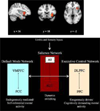The neural circuitry of autism
- PMID: 21213096
- PMCID: PMC4542151
- DOI: 10.1007/s12640-010-9234-7
The neural circuitry of autism
Abstract
Autism is a complex neurodevelopmental disorder, characterized by deficits in social emotional, and language domains, as well as repetitive restrictive behaviors. The vast heterogeneity of the clinical and behavioral symptoms has made it rather difficult to delineate the neural circuitry affiliated with these domains of dysfunction. The current review aims at broadly outlining the latest research into the neurobiology and neural circuitry underlying the core domains of deficits in autism. We further discuss new avenues of research that can further our understanding of the dimensions of this complex disorder.
Figures










References
-
- Adolphs R, Gosselin F, Buchanan TW, Tranel D, Schyns P, Damasio AR. A mechanism for impaired fear recognition after amygdala damage. Nature. 2005;433:68–72. - PubMed
-
- Adolphs R, Sears L, Piven J. Abnormal Processing of Social Information from Faces in Autism. Journal of Cognitive Neuroscience. 2001a;13:232–240. - PubMed
-
- Adolphs R, Sears L, Piven J. Abnormal processing of social information from faces in autism. J Cogn Neurosci. 2001b;13:232–240. - PubMed
Publication types
MeSH terms
Grants and funding
LinkOut - more resources
Full Text Sources
Other Literature Sources

